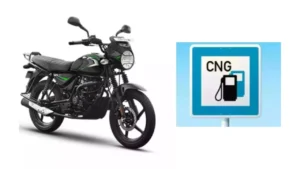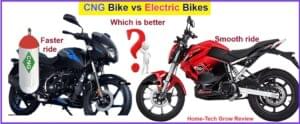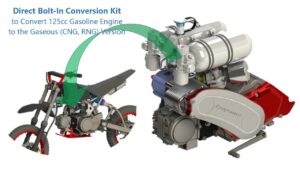Comparison of CNG and Electric Bike
Is CNG better than an electric bike?
- When comparing CNG bikes and electric bikes in the context of India, several factors specific to the Indian market need to be considered, including infrastructure, government policies, and the typical usage patterns of Indian consumers.
- CNG might not be as clean a fuel as electricity, but it is the more sensible choice in the current scenario.
- The Lovato CNG kit makes a scooter retain the utility of a normal petrol-powered scooter while giving you the option of a more economical and cleaner fuel
CNG Bike is faster than an electric bike?
- Gas bikes are faster, noisier, heavier, less efficient, cheaper to purchase, more expensive to maintain, and have a longer range.
- An Electric bike is slower, lighter, quieter, more efficient, more costly to purchase, cheaper to maintain, and has a shorter range
- Here’s a detailed comparison to help you decide:

Infrastructure and Availability
- Electric Bikes:
- Charging Stations: The infrastructure for electric vehicle (EV) charging is rapidly expanding, especially in urban areas. Many cities now have public charging stations, and some residential complexes and workplaces are installing private charging points.
- Battery Swapping: Some companies offer battery swapping services, which can reduce downtime and make electric bikes more convenient.
- CNG Bikes:
- Refueling Stations: CNG refueling infrastructure is concentrated in certain areas, particularly in metropolitan cities like Delhi, Mumbai, and Pune. Availability in rural areas and smaller cities is limited compared to urban centers.
Government Policies and Incentives
- Electric Bikes:
- Subsidies and Incentives: The Indian government offers various incentives for electric vehicles under the FAME (Faster Adoption and Manufacturing of Hybrid and Electric Vehicles) scheme. These include subsidies, tax benefits, and reduced registration fees.
- Policy Support: Policies are increasingly favoring electric vehicles to reduce pollution and reliance on fossil fuels.
- Refer to the post for Government Subsidy for different Electric Vehicles Statewise
- CNG Bikes:
- Subsidies: CNG vehicles also receive some support, but the focus is more on public transportation and larger vehicles.
- Policy Support: Less emphasis compared to electric vehicles, with more support directed towards reducing vehicular emissions through electrification.

Environmental Impact
- Electric Bikes:
- Zero Emissions: Electric bikes produce no tailpipe emissions, which is crucial for improving air quality in congested cities.
- Energy Source: The environmental benefit is higher when the electricity comes from renewable sources.
- CNG Bikes:
- Lower Emissions: While CNG bikes emit fewer pollutants than petrol or diesel bikes, they still contribute to greenhouse gas emissions.
Comparison with Electric Bikes
- Environmental Impact: Both CNG and electric bikes are more environmentally friendly than petrol bikes. However, electric bikes have zero tailpipe emissions, whereas CNG bikes still emit some pollutants.
- Running Costs: Electric bikes tend to have lower running costs compared to CNG bikes due to the lower price of electricity.
- Infrastructure: The charging infrastructure for electric bikes is growing, but CNG refueling infrastructure is also expanding.
- Performance: Electric bikes can offer better performance in torque and acceleration.
- Range and Refueling/Recharging Time: CNG bikes can be refueled quickly compared to the longer recharging time of electric bikes, though electric bikes typically have a shorter range per charge.
Cost and Maintenance
- Electric Bikes:
- Running Costs: Lower running costs due to cheaper electricity compared to CNG and petrol.
- Maintenance: Fewer moving parts lead to lower maintenance costs. Battery replacement can be a significant expense but is less frequent.
- CNG Bikes:
- Running Costs: Lower than petrol bikes but higher than electric bikes.
- Maintenance: Similar to petrol bikes, with added maintenance for the CNG system.
Usability and Performance
- Electric Bikes:
- Range: Typically lower range per charge compared to CNG, but sufficient for daily urban commutes. Range anxiety can be mitigated by charging infrastructure.
- Performance: Instant torque and smoother ride.
- CNG Bikes:
- Range: Better range compared to electric bikes, making them suitable for longer commutes.
- Performance: Comparable to petrol bikes with slightly reduced power.
Future Prospects
- Electric Bikes:
- Growth Potential: High growth potential with increasing investments in technology and infrastructure.
- Innovation: Continuous advancements in battery technology and energy efficiency.
- CNG Bikes:
- Growth Potential: Limited compared to electric bikes. Seen more as a transitional technology.

CNG bikes in India

Cost of Electric Bike In India
Summary
- Choose an Electric Bike in India if:
- You have access to charging infrastructure.
- You want an eco-friendly, low-maintenance option for urban commutes.
- You can benefit from government incentives.
- Choose a CNG Bike in India if:
- You have easy access to CNG refueling stations.
- You need a bike with a longer range for commuting.
- You prefer a more traditional biking experience with lower emissions than petrol bikes.
- Overall, electric bikes are likely the better long-term option in India due to the government’s focus on promoting electric vehicles, expanding charging infrastructure, and the environmental benefits.
- CNG bikes present a viable option for reducing emissions and operating costs in India, complementing the growing market of electric bikes.


